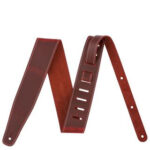Yes, many blues and rock licks are considered clichés, but there’s a compelling reason for their enduring popularity: they sound incredibly cool. Both listeners and guitarists are drawn to them, wanting to hear and play these iconic phrases repeatedly. For guitarists dedicated to mastering the blues, these licks serve as a crucial rite of passage and an inexhaustible wellspring of inspiration. They form the bedrock upon which any solid blues guitar foundation is constructed.
This lesson presents 12 classic Blues Guitar Licks, each with a proven track record of enhancing blues performances. You can seamlessly integrate any of these into a blues-based progression and instantly elevate your sound. Alternatively, you can combine them in sequence over a standard 12-bar blues structure to craft a captivating and sophisticated solo, as we’ll demonstrate in the final section of this lesson.
Before we delve into these essential licks, let’s familiarize ourselves with three fundamental blues scale patterns that underpin these phrases. A quick practice session with these shapes will prepare your fingers and mind for the lesson ahead.
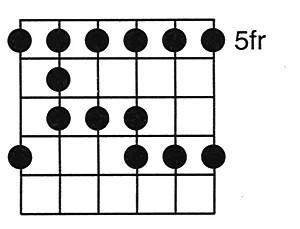 Figure 1
Figure 1
Figure 1: Full A Blues Scale Pattern in 5th Position for Blues Guitar Licks
Figure 1 illustrates a comprehensive A blues scale pattern in the 5th position. Note its composition: the root, b3rd, 4th, b5th, 5th, and b7th degrees of an A major scale. All the licks we will explore are presented within the context of an A major blues progression. This foundational scale pattern is crucial for understanding and executing classic blues guitar licks.
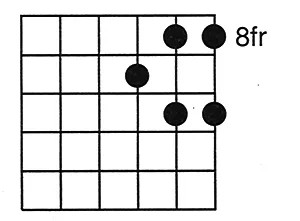 Figure 2
Figure 2
Figure 2: Reduced A Blues Scale Pattern – The “Albert King Box” for Blues Guitar Licks
The second pattern, Figure 2, is a condensed version of the A blues scale, encompassing only the root, b3rd, 4th, 5th, and b7th. This compact and highly practical shape is affectionately known as the “Albert King Box.” Albert King, a blues guitar legend, frequently utilized this position, particularly after joining Stax/Volt Records in 1966. Its finger-friendly nature makes it an ideal starting point for learning blues guitar licks.
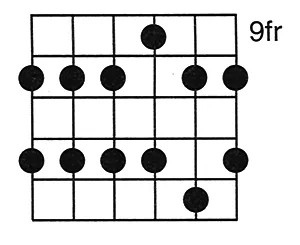 Figure 3
Figure 3
Figure 3: Extended A Blues Scale Pattern – The “B.B. King Box” for Blues Guitar Licks
Figure 3 presents the “B.B. King Box,” a pattern commonly associated with the iconic B.B. King, who extensively used it from the 1960s onwards. This pattern contains the same scale degrees as the “Albert King Box” but expands across a larger section of the fretboard, offering more melodic possibilities for blues guitar licks and solos.
With your fingers warmed up and your mind focused, let’s embark on a journey through these 12 essential blues guitar licks, drawing inspiration from musical hotspots ranging from Mississippi to Texas, with significant stops in Chicago, Memphis, and New Orleans.
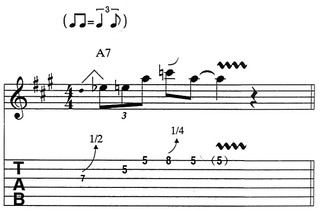 Figure 4
Figure 4
Figure 4: T-Bone Walker Inspired Opening Blues Guitar Lick in A
Our first lick, Figure 4, is a striking opening phrase perfectly suited for playing over a I chord in a blues progression. This lick evokes the style of T-Bone Walker, a pioneer of electric blues guitar. Walker frequently incorporated similar dynamic licks in his signature tunes like “Description Blues” and “Alimony Blues.” The expressive bends to the b5th (Eb) and the blue note (between C and C#) establish a definitive blues tonality. The resolution to the root (A) of the I chord provides a natural transition to the next lick, allowing for the creation of a dynamic and evolving blues solo.
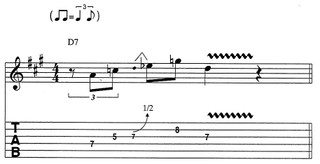 Figure 5
Figure 5
Figure 5: B.B. King Style Blues Guitar Lick Resolving to the IV Chord
B.B. King, the undisputed “King of the Blues,” often employed licks similar to Figure 5, notably in his performance of “Sweet Little Angel” from Live at the Regal. This lick masterfully utilizes bends to the b5th (Eb) and b7th (G), creating tension and anticipation before smoothly resolving to the 4th (D), which is the root of the IV chord in a standard blues progression. This lick is ideal for transitioning from the I chord to the IV chord within a blues context.
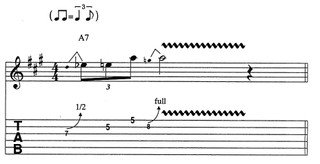 Figure 6
Figure 6
Figure 6: Classic B.B. King I Chord Blues Guitar Lick
No compilation of great blues guitar licks would be complete without including several quintessential B.B. King phrases. Figure 6 exemplifies a classic I chord lick, popularized by B.B. King in countless songs, including “Please Love Me,” and widely adopted by blues guitarists worldwide. The crucial element of this lick is the bend of the b7th (G) up to the root (A). It should be executed using the pinkie finger, supported by the ring, middle, and index fingers for strength and control. Accurate intonation and a steady, wide vibrato are essential to make this lick truly sing with bluesy emotion.
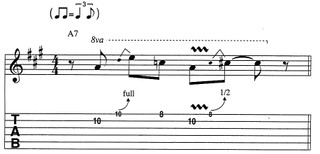 Figure 7
Figure 7
Figure 7: Iconic Albert King Blues Guitar Lick with Bends and Vibrato
Figure 7 showcases the signature Albert King lick, instantly recognizable from blues classics like “Crosscut Saw” and “Born Under a Bad Sign.” This lick possesses a distinctive character, hovering and swooping like a bird of prey. Begin with your ring finger, using it for both the full-step bend and the repetition of the root (A). Employ your index finger for the b3rd (C) and the bend and vibrato on the major 3rd (C#). The dynamic interplay of bends and vibrato is key to capturing the expressive essence of Albert King’s blues guitar style.
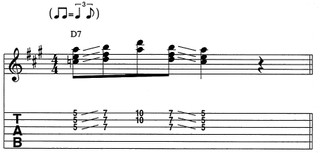 Figure 8
Figure 8
Figure 8: Johnny Moore/Lonnie Mack Style Sliding IV6-to-IV9 Blues Guitar Chord Lick
Stepping momentarily outside the conventional blues scale framework, Figure 8 presents a sliding IV6-to-IV9 chord pattern favored by influential guitarists such as Johnny Moore (known for his work with Charles Brown in the 1940s) and T-Bone Walker. This particular example, incorporating a root-4th (A–D) dyad, was notably used by the underappreciated guitar virtuoso Lonnie Mack in his song “Down and Out.” Execute the slide with your index finger, simultaneously striking the dyad with your pinkie finger. This chordal lick adds a sophisticated harmonic dimension to blues guitar playing.
 Figure 9
Figure 9
Figure 9: Mike Bloomfield Inspired Tangy Blues Guitar Bend Lick
Mike Bloomfield, regarded by many as the first electric guitar hero, was renowned for his tangy and expressive bends, exemplified in Figure 9. This lick is reminiscent of phrases found in Bloomfield’s performances of “Don’t Throw Your Love on Me So Strong” and “I’ve Got a Mind to Give Up Living.” Bend the b7th (G) of the scale up to the root (A) using your ring finger, and sustain the bend while adding the b3rd (C) with your pinkie finger. The resulting dyad (A–C) creates the 5th and b7th of the IV chord, reinforcing its bluesy, dominant 7th character.
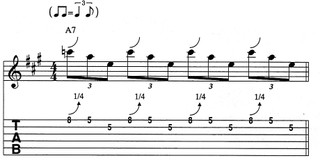 Figure 10
Figure 10
Figure 10: B.B. King Triplet Pattern Blues Guitar Lick with Quarter-Note Bends
B.B. King frequently incorporated slippery triplet patterns like the one shown in Figure 10 to build tension and excitement in his solos. The quarter-note bend initiating each beat imparts a captivating elastic feel to the lick. B.B. King famously played this pattern in “Three O’Clock Blues,” and it’s quite plausible that Eric Clapton drew inspiration from this groundbreaking hit. This triplet lick is a valuable technique for adding rhythmic complexity and blues phrasing to your guitar solos.
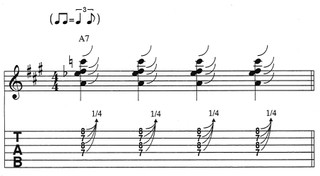 Figure 11
Figure 11
Figure 11: T-Bone Walker Powerful Diminished Chord Voicing Blues Guitar Lick
The legendary T-Bone Walker often captivated audiences with powerful diminished chord voicings, such as the one presented in Figure 11, which he showcased in tunes like “Strolling with Bones.” Notice that the root (A), b5th (Eb), and b3rd (C) are derived directly from the A blues scale, while the 6th (F#) subtly hints at the A Mixolydian mode. When playing this chord from low to high strings, use your index, ring, middle, and pinkie fingers. Pay close attention to the subtle quarter-step bend, which adds a crucial touch of blues inflection to this sophisticated chord lick.
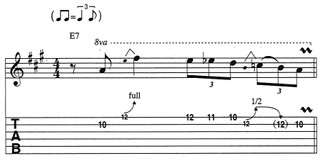 Figure 12
Figure 12
Figure 12: B.B. King Climactic Blues Guitar Lick with Chromatic Run
B.B. King often utilized climactic licks similar to Figure 12, as heard in King of Guitar. Begin with your index finger, then switch to your ring finger for the full-step bend from the 5th (E) to the 6th (F#). Descend the chromatic run (E-Eb-D) using your ring, middle, and index fingers. Articulate the half-step bend with your ring finger. Note the incorporation of Eb as a passing tone between E and D, and the half-step bend from B to C—neither of which are strictly part of the A blues scale. These chromatic elements add a touch of unexpected melodic color to this exciting lick.
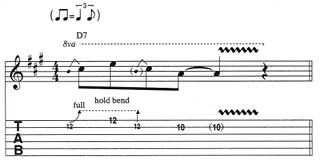 Figure 13
Figure 13
Figure 13: B.B. King “King’s Special” Style Blues Guitar Lick with Vibrato
Figure 13 presents another B.B. King-esque lick in the vein of “King’s Special.” Bend up to the 3rd (C#) with your ring finger, sustaining the bend while playing the 5th (E) with your pinkie finger. Vibrate the root (A) with your index finger, employing a rapid, hummingbird-like vibrato. This lick effectively combines bending, double stops, and vibrato, showcasing essential blues guitar techniques.
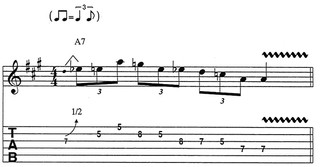 Figure 14
Figure 14
Figure 14: Freddie King Scalar Turnaround Blues Guitar Lick
Freddie King continues this exploration of blues licks with Figure 14, which is reminiscent of phrases found in “Torn Down.” The use of the b5th (Eb) played straight, rather than bent to, lends a slightly jazzy flavor compared to typical blues phrasing. However, this pattern serves as an excellent turnaround lick over the I chord when you want to maintain a scalar approach. This lick demonstrates how to incorporate scalar runs into your blues guitar vocabulary.
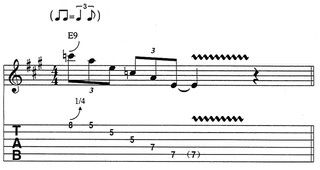 Figure 15
Figure 15
Figure 15: Jimi Hendrix “Red House” Inspired Blues Guitar Lick
This final lick, Figure 15, likely has roots in the playing of B.B. King, but it was Jimi Hendrix’s iconic rendition of “Red House” that solidified its place in the blues guitar hall of fame. Ensure that you barre fret 5 with your index finger after the blue note bend at fret 8. Use a single continuous upstroke to execute the rapid descending run to the 5th (E). Play the root (A) with your ring finger, crossing over it with your middle finger to access the 5th. This lick encapsulates the raw energy and expressive bending characteristic of blues-rock guitar playing.
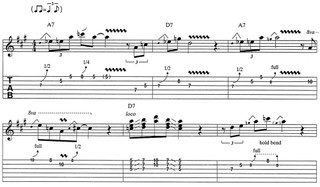 Figure 16 (1)
Figure 16 (1)
Figure 16a: Measures 1-8 of 12 Blues Guitar Licks Solo Example
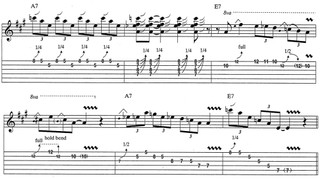 Figure 16 (2)
Figure 16 (2)
Figure 16b: Measures 9-16 of 12 Blues Guitar Licks Solo Example
Figure 16 presents a straightforward demonstration of how to combine these 12 licks into a cohesive solo. We’ve simply played them in sequence, as presented throughout this lesson, with minor rhythmic adjustments for flow. We encourage you to try the same yourself. Remember that all of these blues guitar licks are transposable, meaning you can move them up or down the fretboard to fit any key. Find a lick or two that particularly resonate with you and practice them extensively in different positions along the neck. This will significantly expand your blues guitar vocabulary and improvisational skills.

